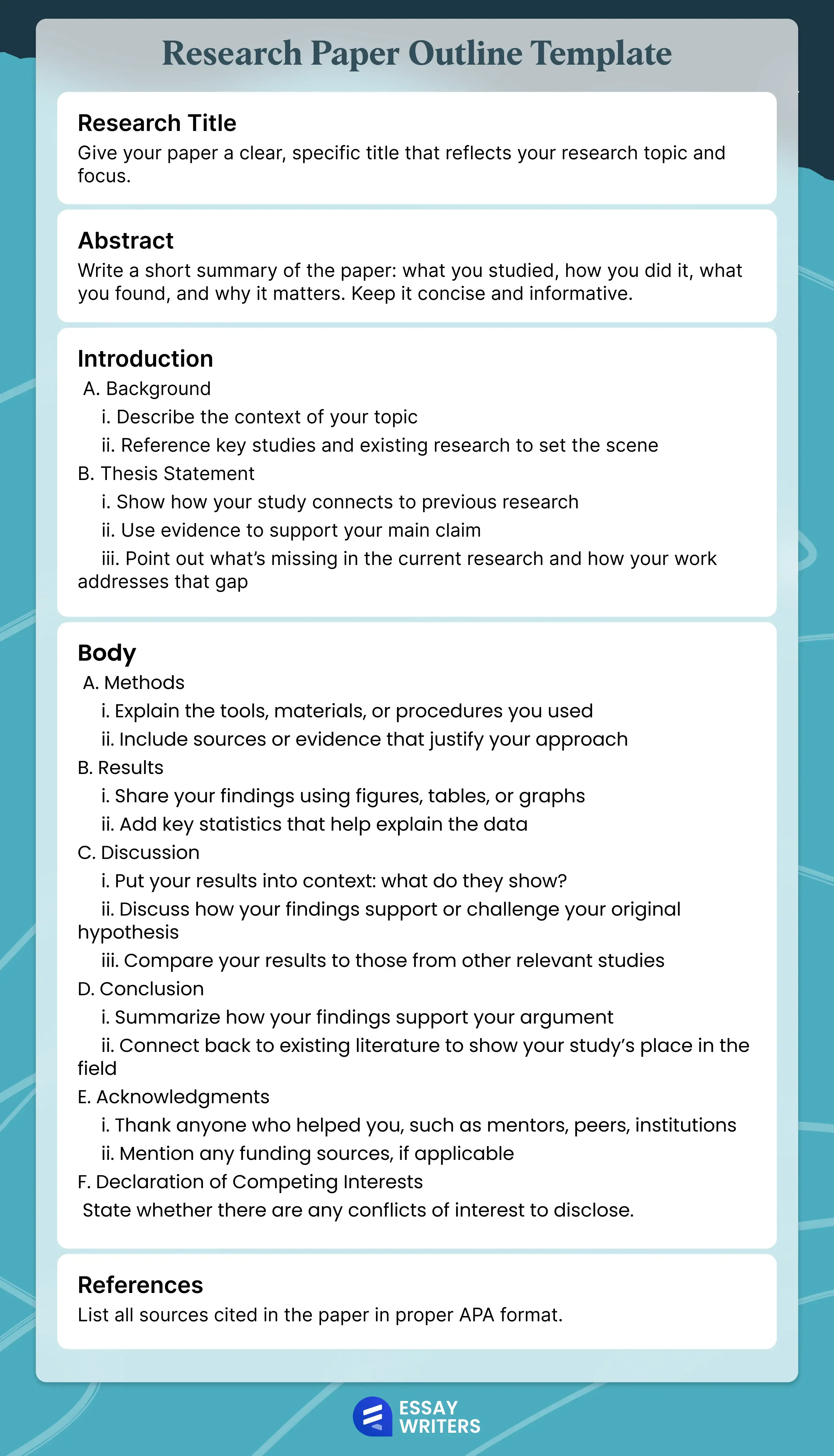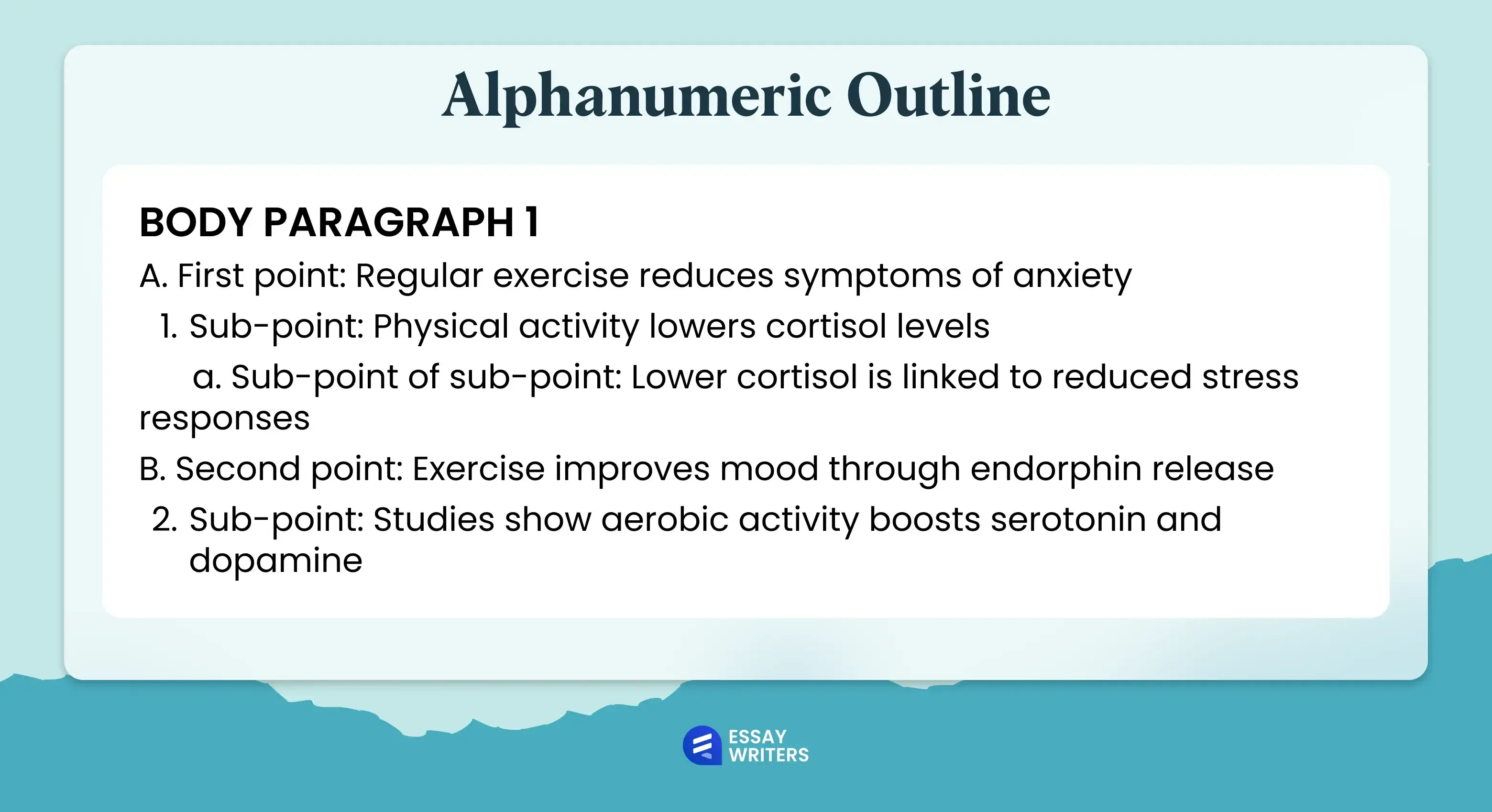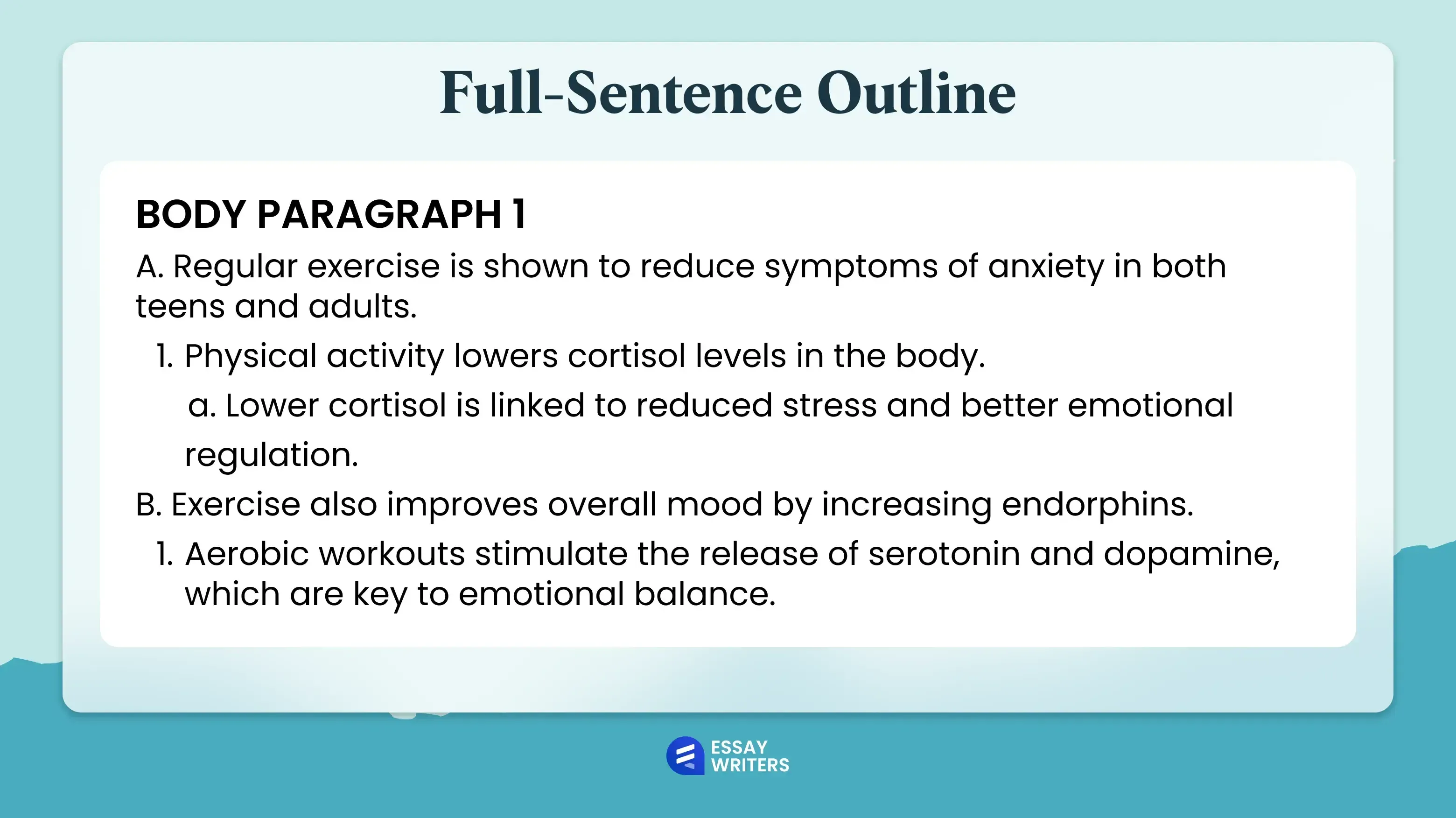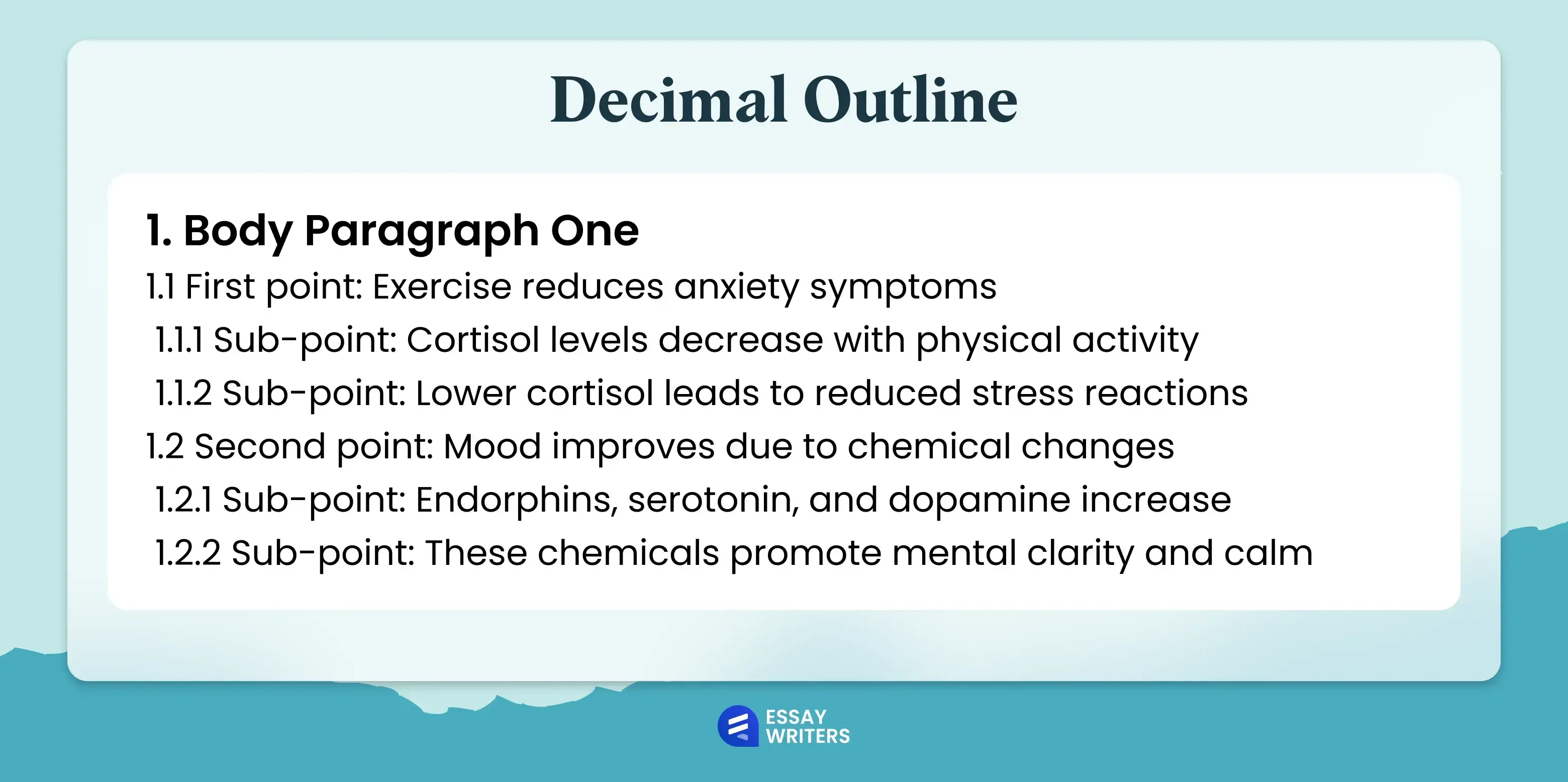
How to write
Research Paper Outline Template: How Structure Can Save You
Author: Michael Perkins
Updated: Jul 28, 2025
min
Table of contents
Every solid research paper starts with a structure: a title page, an abstract, an introduction, methodology, results, discussion, and acknowledgments. These are the key components that keep the whole paper from collapsing in on itself.
This article breaks down each section and format to help you build a clear, focused outline template for research paper success in college. And if the process still feels overwhelming, Essay Writers is here for the heavy lifting with expert writing support for students who’d rather not go it alone.
What Is a Research Paper Outline?
An outline for research paper is a structured plan that organizes the major sections of a research paper before the actual writing begins. It maps out key arguments, supporting evidence, and the logical flow of ideas. A well-built outline provides a strong foundation for writing a detailed, coherent, and convincing academic paper from start to finish. A research paper outline helps students stay focused, meet academic requirements, and present their findings clearly.
Research Paper Outline Template
Having a blueprint makes all the difference before writing a single word of your paper. This structured outline makes your writing process faster, cleaner, and way less stressful.

Components of a Research Paper Outline
An outline is a guide behind every clear, confident research paper. It lets you map your thoughts before the writing gets messy, and it shows your reader where they’re headed before they even get there.
A basic research paper outline consists of:
- Title Page
- Abstract
- Introduction
- Methodology
- Results
- Discussion
- Conclusion
- Acknowledgments
- References
Each section plays a role in keeping everything grounded and easy to follow.
Title Page
This is the first thing anyone sees, and while it’s mostly formal, it still matters. The title page includes
- The paper’s title
- Your name
- Your school or department
- The course and the instructor’s name
- The submission date
If you’re using APA, you’ll also add a page number and something called a running head.
Abstract
If someone only had 30 seconds to understand what your research was about, they’d read the abstract. An abstract is a short summary, usually around 150-250 words, that covers your main question, how you approached it, what you found, and what it means. This part of a research outline example often decides if the reader keeps going or moves on.
Introduction
The introduction is where you invite your reader in. You explain what your topic is, why it’s worth paying attention to, and what’s already been said about it. This is also where your thesis statement lives, the main idea you’re going to explore or argue throughout the paper. Done right, this section builds interest and trust from the very beginning.
Methodology
Here’s where you walk the reader through what you actually did. What kind of data did you collect? How did you collect it? What tools or steps did you use? With methodology, you’re showing exactly how your research took shape so that someone else could understand or even repeat it.
Results
This section shows what you discovered. You’re laying out the facts, charts, tables, graphs, and raw numbers, but you're not interpreting anything yet. Your job here is to present the data clearly, without over-explaining, and let the evidence speak for itself.
Discussion
What do those results mean? How do they relate to your original thesis? Were they what you expected? This section is where you make sense of everything and explain how your research fits into the bigger picture. If there were any surprises, this is the place to unpack them.
Acknowledgments
If you had help, for example, if someone reviewed your drafts, supported your project, or funded your work, this is where you give them credit. It’s not just a formality. It’s a moment to recognize the people or organizations that made your research possible. A small section, but a meaningful one.
Formats of Research Paper Outline
Outlining a research paper for college isn’t one-size-fits-all. Some people like bullet points. Others need full sentences to feel like they’re making progress. And then there are those who want everything numbered to the decimal. There’s a format for each of those brains. The three main types are alphanumeric, full-sentence, and decimal.
Alphanumeric Outline
This is the format most students use without even thinking about it. It starts with Roman numerals for big sections (like your intro or methods), then breaks them down using capital letters, numbers, and lowercase letters. Creating an outline like this is great when you need a solid structure without writing everything out just yet.

Full-Sentence Outline
If you think better in full thoughts rather than fragments, this format helps your ideas take shape early. Each point in the outline is written as a complete sentence. You’re writing out, ‘This paper will explore how social media habits influence attention spans among teenagers.’ It brings clarity early and helps your draft fall into place faster. You can use it for your essay, research paper, and other assignments.

Decimal Outline
If you already know where everything fits, or you’re working on a complex topic that has a lot of layers to unravel, the decimal format is the perfect choice. This research outline template breaks your paper down with numbers like 1.0, 1.1, 1.1.1, showing how each idea builds on the last. It’s especially useful in research-heavy subjects where keeping track of your sections matters.

How to Write a Research Paper Outline?
Before you start, there are a few things you need to know about a rough draft:
- Pick a topic you actually want to explore
- Narrow it down to a clear research question
- Gather sources that help you understand the topic better
- Decide what your main argument or thesis will be
- Break your paper into sections: intro, body, conclusion
- Add bullet points or full sentences under each section
- Choose a format that feels natural and easy to follow
- Look it over, make adjustments, and you're ready to write
If outlining still feels overwhelming, our college essay writers can guide you through the process and help turn your ideas into a clear, effective paper.
Research Paper Outline Example
Now, let’s have a look at a sample research paper outline on The Psychological Effects of Remote Learning on High School Students, created by our professional essay writers.
I. Title Page
- Title: Disconnected or Empowered? The Psychological Impact of Remote Learning on Teens
- Includes name, school, course, instructor, date, running head, and page number (APA format)
II. Abstract
- 150–250 words summarizing research question, methods, key findings, and conclusion
- Focus: Effects of remote learning on teen mental health, motivation, and social connection
III. Introduction
- Rise of remote learning post-pandemic
- Research Question: How has remote learning affected teen mental health?
- Thesis: While flexible, remote learning increased isolation, lowered motivation, and raised new mental health concerns
IV. Methodology
- Participants: 200 high school students (urban & rural)
- Data Collection: Online surveys on anxiety, motivation, and social ties
- Procedure: 3-month anonymized data collection
- Analysis: Descriptive and inferential stats
V. Results
- 63% felt more isolated
- 58% struggled with motivation
- Rural students showed higher disconnection
VI. Discussion
- Mixed effects: flexibility vs. emotional cost
- Motivation dropped due to lack of structure
- Social interaction is crucial in schools
- Limitations: Self-reports, short timeframe
- Future Research: Hybrid models over time
VII. Conclusion
- Remote learning changed education, but not without psychological drawbacks. Insights can help shape better support for digital education.
VIII. Acknowledgments
IX. References
The Bottom Line
A simple research paper outline makes writing easier, faster, and way less stressful. It helps you figure out what to say, where to say it, and how everything connects.
- Outlines keep your ideas organized and on track
- Alphanumeric, full-sentence, and decimal are the most common formats
- Each section, from intro to conclusion, has a purpose
- The best outline is the one that works for your brain
If you still feel stuck, our essay writers can help you write your final paper. Getting academic support doesn’t mean you’re behind. It means you’re working smarter. You can also check out our guide on how to write an abstract for a research paper to better structure your introduction and key findings.
FAQs
How Long Should a Research Paper Outline Be?
It can be as long as it needs to be. Some are one page, others are a few. Just make sure it’s clear.
How do I Write a Research Paper Outline?
Start with your thesis. Break the paper into sections. Add points under each. Keep it focused and simple.
What Does a Research Paper Outline Look Like?
It looks like a roadmap, consisting of titles, sections, and supporting points listed clearly, either as phrases or full sentences.
Sources
University of California, San Diego. (n.d.). Research paper structure. UC San Diego Department of Psychology. https://psychology.ucsd.edu/undergraduate-program/undergraduate-resources/academic-writing-resources/writing-research-papers/research-paper-structure.html


